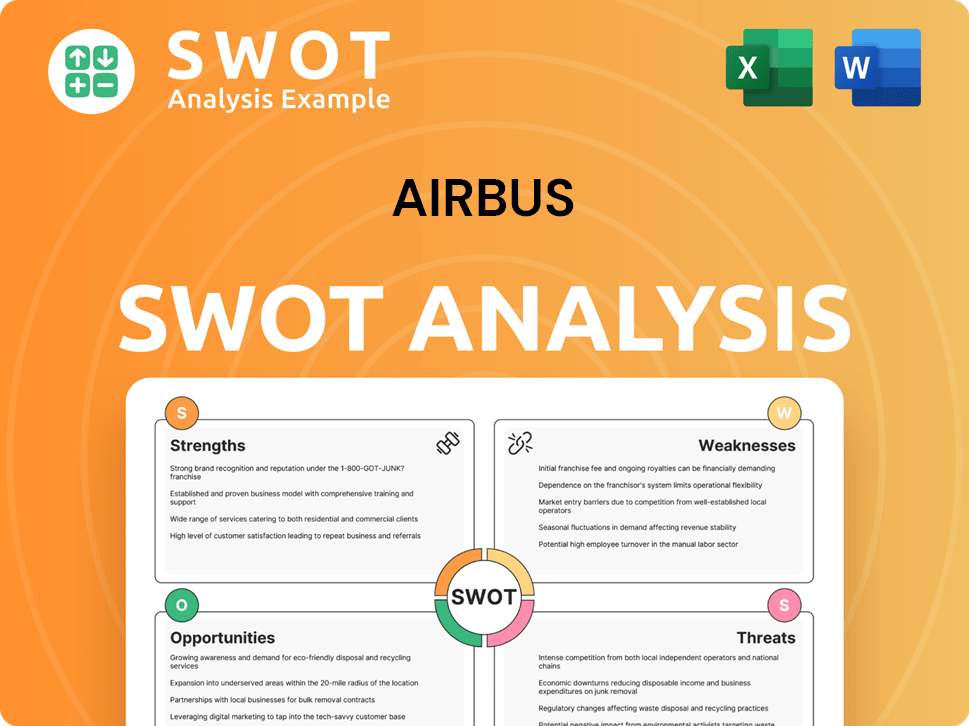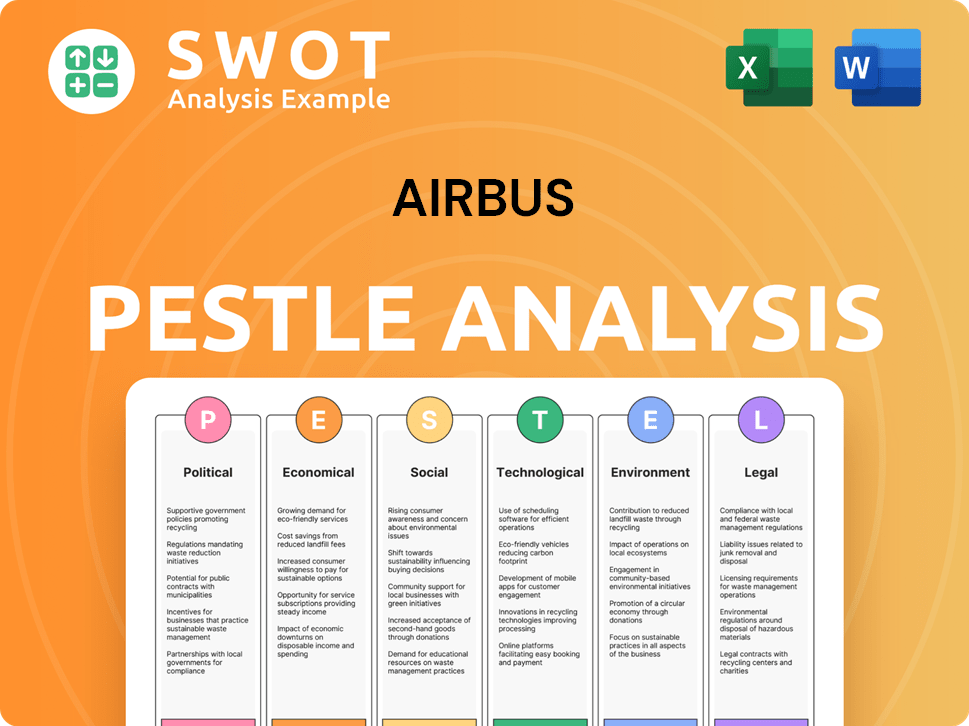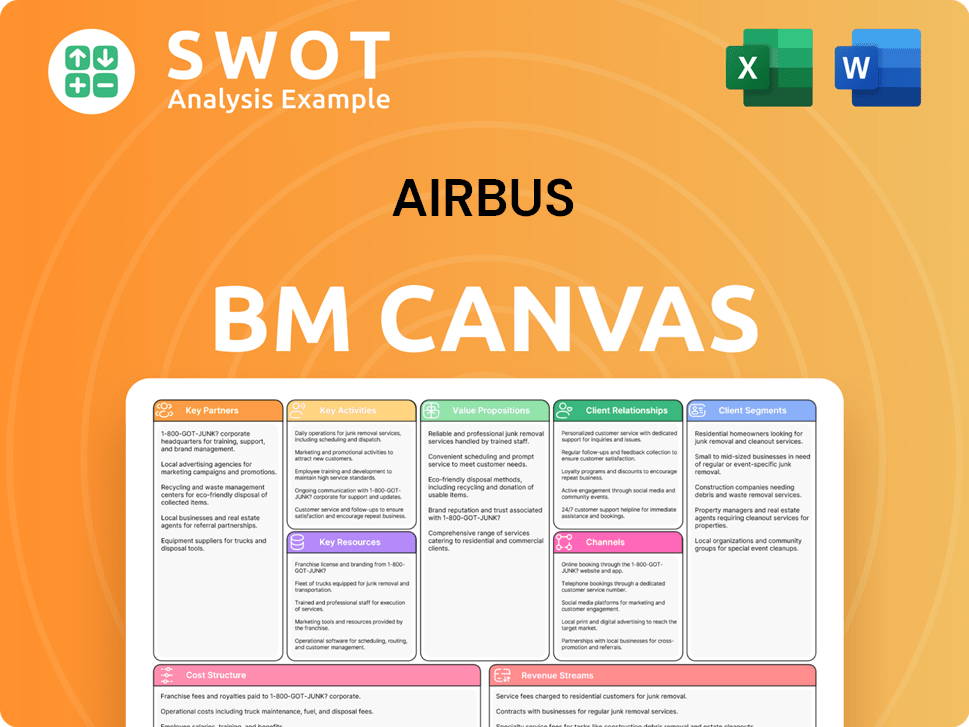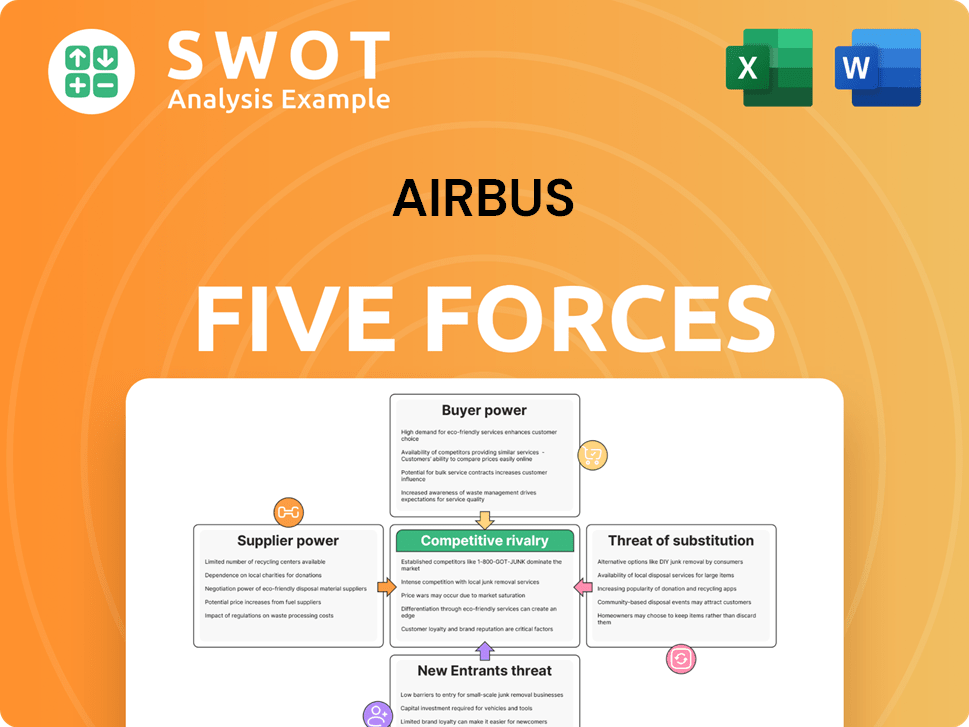AIRBUS Bundle
Can Airbus Maintain Its Ascent in the Aerospace Industry?
Airbus, a titan of the aerospace industry, has consistently demonstrated the critical importance of a robust growth strategy. From its inception as a challenger to established players, Airbus has evolved into a global leader, shaping the landscape of commercial aviation and beyond. This analysis delves into Airbus's strategic roadmap, offering a comprehensive look at its future.

To understand the AIRBUS SWOT Analysis is crucial for understanding its current position and future trajectory. Airbus's future prospects are intertwined with its ability to navigate industry trends and capitalize on emerging opportunities. The company's success hinges on its strategic planning process, continuous innovation, and prudent financial management, all essential for long-term growth. A deep dive into Airbus's business model and market analysis will reveal how it plans to overcome challenges and solidify its position in the competitive landscape, ensuring sustainable growth initiatives.
How Is AIRBUS Expanding Its Reach?
The Airbus growth strategy focuses on several key expansion initiatives to boost its business. These efforts include increasing production rates, entering new markets, and strategic acquisitions. This comprehensive approach aims to solidify the company's position in the aerospace industry and capitalize on emerging opportunities.
A primary element of the Airbus growth strategy involves increasing the production of commercial aircraft. The company is targeting approximately 820 commercial aircraft deliveries in 2025, a significant increase from the 766 aircraft delivered in 2024. This ramp-up in production is crucial for meeting the growing global demand for air travel and maintaining a strong market share. Airbus is also focusing on increasing production rates for specific aircraft models.
Airbus's expansion plans are also evident in its international growth, particularly in regions with high growth potential. The company's strategic moves and new aircraft developments are designed to meet the evolving needs of airlines worldwide.
Airbus aims to increase production rates across its aircraft families. By 2027, the company plans to achieve a production rate of 75 A320 Family aircraft per month. The A220 program is also set for expansion, with a target of 14 aircraft per month by 2026. These production increases are crucial for meeting the growing demand for these popular aircraft models.
Airbus is actively expanding its presence in key markets. In the first quarter of 2025, the company secured 280 gross commercial aircraft orders. The backlog of commercial aircraft orders reached 8,726 at the end of March 2025, demonstrating strong demand and confidence in Airbus's products. This robust order book supports the company's long-term growth strategy.
Saudi Arabia is making significant investments in Airbus aircraft. The kingdom plans to order a substantial number of Airbus jets, including up to 50 A350 widebody aircraft for Riyadh Air. This move aligns with Saudi Arabia's goal to triple its aviation capacity by 2030. The partnership between Airbus and Saudi entities is strengthened by a 105-aircraft order in 2024, followed by an additional deal for 20 A330neo aircraft in April 2025.
Airbus continues to develop new products and make strategic acquisitions to enhance its capabilities. The company launched the new H140 multirole helicopter in March 2025, which has already received its first orders. The A350 freighter variant is expected to enter service in late 2027. Airbus is also nearing a deal to acquire operations from Spirit AeroSystems, a key supplier, to stabilize production and address supply chain challenges.
Strategic acquisitions and partnerships are integral to Airbus's expansion strategy. The company is in the process of acquiring operations from Spirit AeroSystems. This move is intended to strengthen Airbus's control over its supply chain and ensure a stable production environment. These strategic moves are vital for maintaining a competitive edge in the aerospace industry.
- Acquisition of Spirit AeroSystems to stabilize production.
- Focus on increasing production rates for key aircraft models.
- Expansion into new markets with significant order intakes.
- Development of new aircraft models, like the H140 helicopter.
AIRBUS SWOT Analysis
- Complete SWOT Breakdown
- Fully Customizable
- Editable in Excel & Word
- Professional Formatting
- Investor-Ready Format

How Does AIRBUS Invest in Innovation?
The core of the Marketing Strategy of AIRBUS focuses on leveraging innovation and technology to foster sustained growth. This approach is evident in the company's substantial investments in research and development, driving advancements across its product lines and services. The company's commitment extends beyond incremental improvements, targeting transformative changes within the aerospace sector.
Airbus actively shapes the future of aviation through strategic investments in cutting-edge technologies. This proactive stance is crucial for maintaining a competitive edge in a rapidly evolving market. The company's emphasis on innovation is not just about staying current; it's about leading the industry towards more sustainable and efficient solutions.
Airbus's innovation strategy is deeply rooted in its commitment to decarbonization and sustainability. The company is heavily investing in alternative fuels and electric propulsion systems, aiming to introduce the world's first zero-emission commercial aircraft by 2035. This focus on environmental sustainability is a key component of its long-term growth strategy.
Airbus allocated a significant amount to research and development. Consolidated self-financed R&D expenses totaled €673 million in Q1 2025.
A major focus is on reducing carbon emissions. The company is aiming for the first zero-emission commercial aircraft by 2035.
Airbus is also pursuing digital transformation and automation to enhance production rates and mitigate supply chain complexities.
The company is developing new product platforms, such as the A350 freighter variant and the new H140 multirole helicopter, to boost growth.
Sustainability initiatives are a core part of its environmental strategy. Airbus is committed to reducing its environmental footprint.
Airbus is focused on preparing future generations of products and services, ensuring continuous innovation within its portfolio.
Airbus's innovation strategy is comprehensive, encompassing various aspects of its operations. The company's commitment to developing new technical capabilities, such as the A350 freighter and the H140 helicopter, demonstrates its commitment to meeting growth objectives and staying competitive in the market. This commitment to innovation is central to its
Airbus focuses on several key areas to drive its growth and maintain its position in the aerospace industry. These areas include significant R&D investments, decarbonization efforts, digital transformation, and new product development.
- R&D Investments: Airbus consistently invests in research and development to push the boundaries of aerospace technology. In Q1 2025, self-financed R&D expenses reached €673 million.
- Decarbonization: A major focus is on sustainable aviation. Airbus is working towards the goal of introducing the world's first zero-emission commercial aircraft by 2035.
- Digital Transformation and Automation: The company is implementing digital technologies and automation to improve production efficiency and manage supply chain challenges.
- New Product Platforms: Airbus is developing new aircraft models, such as the A350 freighter and the H140 multirole helicopter, to enhance its product portfolio and meet evolving market demands.
AIRBUS PESTLE Analysis
- Covers All 6 PESTLE Categories
- No Research Needed – Save Hours of Work
- Built by Experts, Trusted by Consultants
- Instant Download, Ready to Use
- 100% Editable, Fully Customizable

What Is AIRBUS’s Growth Forecast?
The financial outlook for the future of the Airbus company indicates a focus on increased deliveries and improved profitability. Despite facing ongoing challenges, the company is setting ambitious targets for the coming years. This strategic approach is designed to capitalize on the growing demand in the aerospace industry and strengthen its market position.
In 2024, the company reported a solid financial performance. Consolidated revenues reached €69.2 billion, marking a 6% increase compared to the previous year. Net income also saw a significant rise, increasing by 12% to €4.2 billion. These results reflect the company's ability to navigate market dynamics and achieve financial growth.
Looking ahead to 2025, Airbus has set specific financial goals. The company aims to deliver around 820 commercial aircraft. It is also targeting an EBIT Adjusted of approximately €7.0 billion and a Free Cash Flow before Customer Financing of around €4.5 billion. These projections demonstrate the company's confidence in its future growth prospects and its commitment to creating value for its shareholders.
In 2024, the company's consolidated revenues were €69.2 billion, up 6% year-over-year. The EBIT Adjusted was €5.4 billion. Net income increased by 12% to €4.2 billion, showcasing strong financial health.
For 2025, Airbus targets around 820 commercial aircraft deliveries. The company anticipates an EBIT Adjusted of approximately €7.0 billion. Free Cash Flow before Customer Financing is expected to be around €4.5 billion.
The first quarter of 2025 saw consolidated revenues increase by 6% year-on-year to €13.5 billion. Consolidated net income reached €793 million. The gross cash position stood at €26.1 billion at the end of March 2025.
Fitch Ratings upgraded Airbus's Long-Term Issuer Default Rating to 'A' from 'A-' in May 2025, with a stable outlook. This upgrade reflects expectations of improved operating profitability and free cash flow generation.
Fitch anticipates Airbus's EBITDA margin to gradually improve to around 12.5% by 2028. This improvement is expected to be driven by higher deliveries and increased capacity utilization. This indicates a positive trend in the company's operational efficiency.
The company proposed a 2024 dividend of €2.00 per share and a special dividend of €1.00 per share. This proposal reflects the company's confidence in its financial health and its commitment to rewarding shareholders.
AIRBUS Business Model Canvas
- Complete 9-Block Business Model Canvas
- Effortlessly Communicate Your Business Strategy
- Investor-Ready BMC Format
- 100% Editable and Customizable
- Clear and Structured Layout

What Risks Could Slow AIRBUS’s Growth?
The Airbus company faces several potential risks and obstacles as it pursues its growth strategy. Supply chain vulnerabilities and market competition, are key factors affecting the company's future prospects. These challenges require strategic responses to ensure sustained growth and maintain market share.
Airbus is currently navigating significant supply chain disruptions, particularly concerning engine and component shortages. Geopolitical tensions and regulatory changes also pose risks, potentially impacting competitiveness and delivery schedules. These factors necessitate proactive management to safeguard the company's financial performance and operational efficiency.
The company's growth ambitions are subject to several strategic and operational risks, with supply chain vulnerabilities posing a significant challenge. Airbus is grappling with persistent supply chain disruptions, particularly concerning engine shortages from CFM International (LEAP-1A for the A320neo) and component shortages from Spirit AeroSystems for the A350 and A220 models. These issues have led to 'gliders' – undelivered aircraft awaiting engines – and have forced Airbus to adjust delivery forecasts and production targets. As of April 2025, 43 A320neo aircraft were reported idle in Toulouse due to a lack of engines.
Airbus faces persistent supply chain disruptions, especially engine shortages from CFM International (LEAP-1A for the A320neo) and component shortages from Spirit AeroSystems for the A350 and A220 models. These issues have led to undelivered aircraft, impacting delivery schedules and production targets.
Market competition remains a factor, although less pronounced with Boeing's recent challenges. Airbus must continue to innovate and maintain its competitive edge in the commercial aviation market to secure future prospects.
Regulatory changes and geopolitical tensions pose additional risks, potentially affecting competitiveness and delivery schedules. The imposition of tariffs by the U.S. could impact Airbus's operations and financial performance.
The recall of Pratt & Whitney's GTF engines, which power many Airbus models, continues to impact delivery schedules and fleet availability. This issue adds to the operational challenges Airbus faces.
Delays can lead to customer frustration, as seen with airlines like Flyadeal, which expressed skepticism over promised deliveries. Maintaining customer satisfaction is crucial for Airbus's long-term success.
To mitigate these risks, Airbus is collaborating with its supply chain partners and acquiring parts of Spirit AeroSystems. The company's guidance for 2025 assumes no additional disruptions, highlighting its proactive approach.
Supply chain issues, particularly engine shortages (CFM International LEAP-1A), have led to undelivered aircraft and adjustments in delivery forecasts. Component shortages from Spirit AeroSystems also impact A350 and A220 production. As of April 2025, 43 A320neo aircraft were idle.
Market competition, though lessened by Boeing's issues, remains a factor. Regulatory changes and geopolitical tensions, including potential U.S. tariffs, could affect competitiveness and delivery schedules. These factors add to the complexity.
AIRBUS Porter's Five Forces Analysis
- Covers All 5 Competitive Forces in Detail
- Structured for Consultants, Students, and Founders
- 100% Editable in Microsoft Word & Excel
- Instant Digital Download – Use Immediately
- Compatible with Mac & PC – Fully Unlocked

Related Blogs
- What are Mission Vision & Core Values of AIRBUS Company?
- What is Competitive Landscape of AIRBUS Company?
- How Does AIRBUS Company Work?
- What is Sales and Marketing Strategy of AIRBUS Company?
- What is Brief History of AIRBUS Company?
- Who Owns AIRBUS Company?
- What is Customer Demographics and Target Market of AIRBUS Company?
Disclaimer
All information, articles, and product details provided on this website are for general informational and educational purposes only. We do not claim any ownership over, nor do we intend to infringe upon, any trademarks, copyrights, logos, brand names, or other intellectual property mentioned or depicted on this site. Such intellectual property remains the property of its respective owners, and any references here are made solely for identification or informational purposes, without implying any affiliation, endorsement, or partnership.
We make no representations or warranties, express or implied, regarding the accuracy, completeness, or suitability of any content or products presented. Nothing on this website should be construed as legal, tax, investment, financial, medical, or other professional advice. In addition, no part of this site—including articles or product references—constitutes a solicitation, recommendation, endorsement, advertisement, or offer to buy or sell any securities, franchises, or other financial instruments, particularly in jurisdictions where such activity would be unlawful.
All content is of a general nature and may not address the specific circumstances of any individual or entity. It is not a substitute for professional advice or services. Any actions you take based on the information provided here are strictly at your own risk. You accept full responsibility for any decisions or outcomes arising from your use of this website and agree to release us from any liability in connection with your use of, or reliance upon, the content or products found herein.